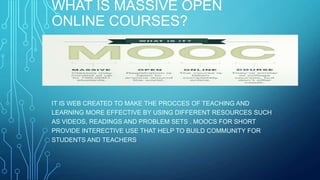Massive Open Online Course ( MOOC )
- 1. WHAT IS MASSIVE OPEN ONLINE COURSES? IT IS WEB CREATED TO MAKE THE PROCCES OF TEACHING AND LEARNING MORE EFFECTIVE BY USING DIFFERENT RESOURCES SUCH AS VIDEOS, READINGS AND PROBLEM SETS . MOOCS FOR SHORT PROVIDE INTERECTIVE USE THAT HELP TO BUILD COMMUNITY FOR STUDENTS AND TEACHERS.
- 2. HISTORY OF MOOC • Even before computers were developed, many teachers were working with educating citizens through informal education programs, that’s when MOOC used developed education movement which helps to broaden access to the learning and teaching offered through formal education systems
- 3. DIFFERENT TYPES OF MOOCS
- 4. • XMOOCS, are video-based specifically were one has to measure short targeted videos, rather than full lesson length ones, with feedback provided via automated testing, they figured automated testing is going to be for some things specifically where one have to measure learning outcomes but the feedback could at times, be an issue. The level of design forethought, expertise and pedagogy has to be high to give good, targeted feedback that as responsive and reflective as that got from instructors. • cMOOCs are the connect model, they are not teacher based but network based. Students connect with one another and engage in a process of social meaning creation. Learning goals and objectives are not prescriptively defined and students navigate their own way through the coursework. Exploration and communication are key and testing and assessment are difficult to challenge students’ creativity.
- 5. CHARACTERISTICS OF MOOC • MOOC doesn’t have any hidden costs, its absolutely free of charge. It can be used to variety of social media and online tools and it also requires no formal entry to be able to participate and have some related discussions in it. Its virtual learning environment is not necessary the center of the course.
- 6. THE BENEFITS OF MOOC • To support lifelong learning or gain an understanding of the subject matter, with no particular expectations for • completion or achievement, • • For fun, entertainment, social experience and intellectual stimulation, • • Convenience, often in conjunction with barriers to traditional education options, • • To experience or explore online education.
- 7. CONTINUES….. MOOCs are designed to enhance student engagement as improving student outcomes is one of the primary goals. According to Trowler and Trowler (2010), Student engagement is the investment of time, effort, and other relevant resources by both students and their institutions intended to optimize the student experience and enhance the learning outcomes and development of students, and the performance and reputation of the institution. (p. 2) Student and instructor participation, motivation, instructional method, and delivery are all important aspects necessary to create a MOOC environment conducive to learning. MOOC educators play a vital role in enhancing student engagement. One of the biggest challenges of MOOCs is the assessment of student performance (Rodriguez, 2012)
- 8. HOW CAN I USE MOOC IN MY FIELD OF INTEREST? • I am a Future life science Teacher so MOOC would be a very effective online way of teaching my learners, simply because I can be able to post or create some group discussions so that learners can discuss and sometimes take notes from it.
- 9. CONTINUES… • While doing this, my learners will get used to use the computer and that will help them not to have problems in their first year of university. • After each and every chapter I would post the lesson outcomes to enable leaners to be aware of what is expected from to know after each and every lesson. • Learners will be able to discuss some ideas themselves which this will result in them understanding better.
- 10. CONCLUSION • MOOCs is a very important education tool that I can advice all teachers to get engaged with since it would help the process of teaching and learning much easier. As I have discussed the benefits of MOOC, and since its so simple to join teachers won’t have any problems in using it.
- 11. REFERENCE LIST. • Trowler, V. & Trowler, P. (2010). Student engagement executive summary. The Higher Education Academy. Retrieved from http://eprints.lancs.ac.uk/61684/1/ Student_Engagement_Project_Executive_Summary._Nov_2010.pdf • Rodriguez, C. O. (2012). MOOCs and the AI-Stanford like courses: Two successful and distinct course formats for massive open online courses. European Journal of Open, Distance and E-Learning. Retrieved from http://www.eric.ed.gov/PDFS/EJ982976.pdf

